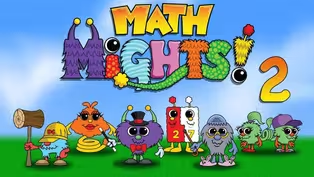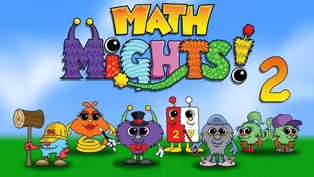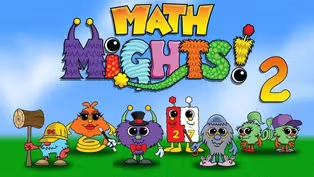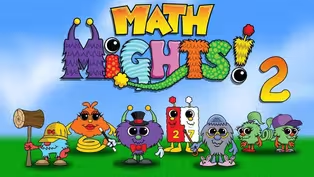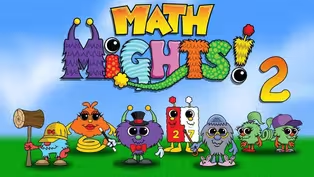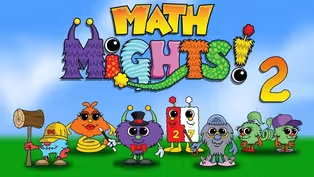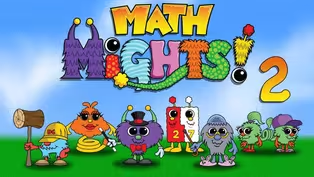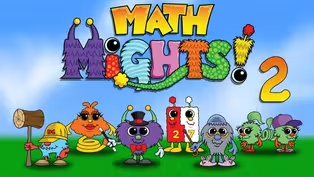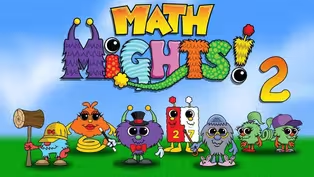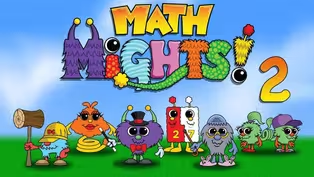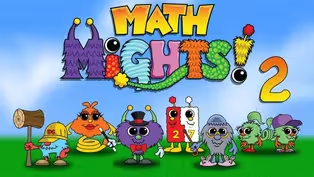Math Mights
Solid Shapes
Season 3 Episode 309 | 15m 59sVideo has Closed Captions
Join Mrs. McCartney for some fun with Professor Barble.
Join Mrs. McCartney for some fun with Professor Barble doing a tricky comparison word problem. Next we are going to explore 3D shapes by identifying and describing their attributes. We will even show you how to create a 3D shape with paper!
Problems playing video? | Closed Captioning Feedback
Problems playing video? | Closed Captioning Feedback
Math Mights is a local public television program presented by Detroit PBS
Math Mights
Solid Shapes
Season 3 Episode 309 | 15m 59sVideo has Closed Captions
Join Mrs. McCartney for some fun with Professor Barble doing a tricky comparison word problem. Next we are going to explore 3D shapes by identifying and describing their attributes. We will even show you how to create a 3D shape with paper!
Problems playing video? | Closed Captioning Feedback
How to Watch Math Mights
Math Mights is available to stream on pbs.org and the free PBS App, available on iPhone, Apple TV, Android TV, Android smartphones, Amazon Fire TV, Amazon Fire Tablet, Roku, Samsung Smart TV, and Vizio.
Providing Support for PBS.org
Learn Moreabout PBS online sponsorshipMore from This Collection
"Math Mights" lessons for 2nd Grade students.
Video has Closed Captions
Join Mrs. McCartney for some fun with Professor Barble. (15m 59s)
Video has Closed Captions
Join Mrs. McCartney for some fun with Professor Barble doing a tricky comparison. (15m 59s)
Video has Closed Captions
Join Mrs. McCartney for a word problem with Professor Barble that will make more sense. (15m 58s)
Video has Closed Captions
Join Mrs. McCartney for a comparison word problem with her friend Professor Barble. (15m 59s)
Compare 3-Digit Numbers Part 2
Video has Closed Captions
Join Mrs. McCartney to learn how to do a comparison word problem with Professor Barble! (15m 59s)
Comparing Numbers on a Number line
Video has Closed Captions
Join Mrs McCartney for a word problem with Professor Barble using Visula Models! (15m 59s)
Compare 3-Digit Numbers Part 1
Video has Closed Captions
Join Mrs. McCartney to see if we can figure out Professor Barble's comparison. (15m 59s)
Numbers represented in different ways
Video has Closed Captions
Representing numbers in different ways to show off your learning with place value. (15m 59s)
Video has Closed Captions
Put numbers together and taking them apart with expanded form. (15m 59s)
Video has Closed Captions
Join Mrs, McCartney for a Number Talk with her friend Springling! (15m 59s)
Video has Closed Captions
Join Mrs, McCartney for a Number Talk with her friend Springling! (16m)
Subtraction with 2-Digit Numbers Part 2
Video has Closed Captions
Join Mrs. McCartney for an addition number talk with D.C.! (16m)
Providing Support for PBS.org
Learn Moreabout PBS online sponsorship(cheerful music) (electronic gadgets whirring and ringing) - [Children] Math Mights!
Welcome, 2nd grade Math Mights.
My name is Mrs. McCartney.
I'm so excited that you've joined us today for our show.
Let's check out our plan for today.
Today, we're gonna do a word problem with my friend Professor Barble.
And then we're gonna start talking about solid shapes.
Let's start first by warming up our math brain as we conquer a word problem with my friend Professor Barble.
He likes to use something called visual models to help him solve word problems.
You may have heard these also be called a bar model, a unit bar, a tape diagram, even a model drawing.
The basic idea of it is that we want it to be a reading comprehension strategy to help you look at the words and figure out exactly how to solve it instead of guessing.
Let's have Professor Barble join us so he can help us.
(triumphant music) Our friend Professor Barble lives in Mathville and he loves to solve word problems.
He likes to help students slow down while they're solving word problems, instead of guessing on how to solve it.
He likes to push on his thinking cap 'cause it helps to create a starting line where he can create the visual model.
Let's check out our word problem for today.
Katie earned 16 more stickers than Peter.
She earned 35 stickers.
How many stickers did Peter earn?
Rihanna says, "Maybe we should add?"
Lynette says, "Or maybe we should subtract?"
Hold on girls.
We're going way too fast.
Professor Barble would want us to first create that visual model.
Let's check out this seven-step checklist that will help us to really visualize what the problem is asking so we don't have to guess if we should add or subtract.
Let's first read our problem by putting chunks in.
You can read it along with me.
We're gonna put a chunk in when we hear a new piece of mathematical information.
Katie earned 16 more stickers than Peter.
Chunk.
That's a great piece of information to be aware of.
She earned 35 stickers.
Chunk.
How many stickers did Peter earn?
Chunk.
Now that we have our three chunks, we know exactly what those different parts of the problem are asking us so it doesn't make it too overwhelming.
Step two is to be able to create a sentence form.
By putting in a complete sentence, we know exactly what we're solving for.
The sentence reads, Peter earned hmm stickers.
The hmm is the part that we're solving for.
We don't know the answer, which is gonna help us when we create our visual model.
Step three is where we add in the who or the what.
As you can see, we have Professor Barble's starting line, which was we have here.
This is a comparison 'cause we're looking at Katie and Peter's stickers.
So I have our who and our what.
As we look at step four, we need to be put in our unit bars.
I already put in the exact same unit bar because this bar right now is representing Katie's stickers.
And this bar down here is representing Peter's stickers.
Step five is the hardest part for 2nd graders.
We have to go back in the word problem and check off the sections that we chunked to make sure we have it inside of our visual model.
I'm gonna read the first sentence to you and we're gonna add that into the visual model.
Katie earned 16 more stickers than Peter.
Let's just say for now they both have the same amount.
Katie has more.
So we're going to extend her bar by adding 16 more stickers to her bar.
Let's go back in the word problem and put in a check.
She earned a total of 35 stickers.
Let's take Katie's whole bar, including the 16 that we added, to show that her total is worth 35 for the amount of stickers that she has.
Let's go ahead and put that check in.
The last sentence asks, how many stickers did Peter earn?
We don't have any information on Peter's bar.
So we're gonna go ahead and put a question mark here.
Let's go back in the word problem and check it off.
Three checks, three chunks.
We have all of our information in our visual model.
Step six is to correctly compute.
Now that we have that visual model, Lynette said, "Slowing down really helped.
"Thanks Professor Barble."
And our friend Lynette says, "Oh wow, "I didn't understand the problem at first, "but seeing that visual model really helps."
Now as we start to compute the problem, we have to solve for Peter's stickers.
We don't really have any information, but there is information that we can use on Katie's bar.
Her total is 35.
If we were to eliminate this 16, it would help us figure out the value here, which is the same size as Peter's bar here.
Let's try taking that 35 and subtracting 16.
This will help us to solve this a lot easier.
For subtraction, I really like to use Springling as my strategy because I like to count up or back on a number line.
If you have a different strategy to use, that's totally fine.
I'm gonna start my number line at 16 and end it at 35.
I'm gonna hop to a friendly decade number, 20, because I know the distance between 16 and 20 is four.
I'm gonna hop up to another decade number, which is 30, which is only 10 away.
And then from 30 to 35, we know it's five.
If I add these together, it'll tell us the distance between 16 and 35, which will help us to subtract that 16.
I know that 10 plus 5 plus 4 equals 19.
We know that if this bar equals 19, because 19 plus 16 equals 35, that will tell us exactly how many stickers Peter had.
Now, if we didn't have that visual model, this would be really difficult to help us to solve this problem.
That's why as we start to get older and learn more things about math, this visual model process is very helpful.
Now we can go back to our sentence form for step seven and fill in our answer.
Peter earned 19 stickers.
Great job using Professor Barble's step-by-step visual model process to help us to solve that problem.
I want you to use this process on any word problem that you encounter in 2nd grade.
Let's check out our I can statement for today.
I can identify and describe solid shapes.
I want you to take a look at these four images.
What do you notice?
What do you wonder?
Let's check out to see what our friends think.
Our friend Rihanna noticed that there's lots of squares.
The cube is even made of squares.
Let's see what Lynette notices.
She says, "The T-shape one is made of six squares."
She is correct.
There's four in the middle and then two on the sides.
Let's take a look at what they wonder.
Rihanna says, "How many little cubes are in that big cube?"
Wow!
That would take us a while to count that, but that's a great wonder.
Lynette says, "I wonder if A is part of D?"
Well, she's kind of right.
I do see a square here and I see a square here.
This one looks a little bit different.
Looking at these four, how are they alike and how are they different?
When you look at these different shapes, you can see that some of them are flat shapes like we've worked with before.
So I think they're the same.
Like we pointed out, they all have squares, but these are flat and these are more three-dimensional.
We did a great job looking at those four pictures.
We really want to focus on the pictures that we had that had the cube, so we're gonna be talking about three-dimensional shapes.
Let's first take a look at the idea of a cube.
Here you can see a cube, which has six faces.
They're all of equal size.
And in fact, it looks a lot like a box.
Let's check out these cubes that we have here.
The cubes might be different sizes, but all of them have six faces.
They're all the same size.
And if you look at it, it'll say you can open up and put it into a box.
That's a shape that's probably one that you're really familiar with.
Another three-dimensional shape that we can look at is called a cone.
A cone has one face, which is a circle.
It has one corner at the tippy top.
And if you look at it, it looks a lot like a party hat.
Here we have cones of different sizes, but all of them have one face as a circle, and then they have one corner at the top.
It looks a lot like construction cones that you might see.
Or even if we flip it this way, it looks like an ice cream cone.
It's really interesting to look at the faces of the shapes.
I wonder if this neck shape is gonna have a face?
It's called a sphere.
A sphere has no faces and it looks a lot like a baseball.
Here I have a sphere.
It has no corners and it has no faces.
It's completely round, but yet it is three-dimensional.
We saw that sphere.
I wonder if any shape has any rounding in it, if it will always be a sphere?
Let's check out this next shape.
It's called a cylinder.
A cylinder has two faces that are circles, but it rolls.
It looks a lot like a can or a tube.
When we look at these, I do see the rounded edges, but in fact it does have two circle faces on it.
So a cylinder can roll, but it's not a sphere because it has the two faces on it.
Let's take a look at the next shape.
This is called a rectangular prism.
It has six faces that are quadrilaterals.
Do you remember what a quadrilateral is?
A quadrilateral has four corners and four sides.
So this shape has six faces that are like that.
Four of the faces are rectangle, and it might look like a tall box.
Let's check it out here.
Here, we do see that all six are quadrilaterals because they have four sides and four corners.
One, two, three, four of them are shaped as a rectangle.
And then in the bottoms, it has the two squares.
This does look like a really large box that you could put something in.
Let's look at this last one.
It's called a pyramid.
One face is a square on this particular pyramid.
It also has four faces that are triangle.
It looks a lot like a tent or a teepee.
If I look at the bottom, this one's base is a square.
And as you can see, there's one, two, three, four triangles for it to stand up on.
Wow, we just learned a lot about different three-dimensional shapes.
The sphere was completely round and was the only one that didn't have any faces, but the faces were all different shapes and sizes.
I want to see now if we can take what we learned and try to play a game.
The game is called, what shape is missing?
We're gonna give you some clues to the shape to see if you can figure out what shape we're talking about.
Rhianna wants us to decide what the missing shape is.
She gives us a clue and says, "The missing shape is triangular."
Lynette says, "It's hard to tell "because it could be a cone or it could be a pyramid."
If I look at the pyramid, I definitely see the triangle here.
And I do see what Lynette is thinking, that the cone has kind of a triangular look to it as you're looking at it.
Let's see if Rihanna can give us some more clues to figure out what the missing shape is.
She says that the missing shape has four triangle faces and one square bottom.
It stands on this.
Lynette knows it's a pyramid.
As we look at the pyramid, it has the square bottom.
And then we can see that it has four triangle faces.
And it does sit up on the square bottom.
That was really fun trying to figure out what Rihanna's missing shape was.
We had to listen to the different attributes of the characteristics that she was giving us to figure out which solid shape she was describing.
Let's make this just a little bit harder to see if you can figure out the 3D shape based on a flat image.
Let's see.
Let's look at this shape and design and decide what 3D shape it is.
I have it here in front of me.
It has these four rectangles and two squares.
It has a total of one, two, three, four, five, six quadrilaterals because they have four sides and four corners.
These are the 3D shapes that we have described.
Which one, if I were to cut this out, do you think would match up to the three-dimensional shape that you see in front of you?
Do you remember back to the characteristics of those different shapes that we talked about?
I have it cut out and I'm gonna see as I'm folding it if you can figure out which one it is.
I have the shape cut out here and I have folded on each of the different lines.
As I go to put this shape together, does it look like any of the three-dimensional shapes that you might see?
I think it looks a lot like our rectangular prism.
In fact, if we look at it, you can see that it has the four rectangles and the two squares, which matches.
So we can take that flat shape and we can put it into a solid shape.
That was kind of fun to be able to take a shape, cut it out and fold it and make a solid shape out of it.
Now it's your turn to match up 3D shapes like we learned today.
Boys and girls, I've had such a great time hanging out with you today.
I sure hope to see you soon.
(playful music) (cheerful whistling music) - [Boy] Sis4teachers.org.
- [Girl] Changing the way you think about math.
- [Announcer] This program is made possible with funding from the Michigan Department of Education, Governor's Education Emergency Funds, the State of Michigan, and by viewers like you.
(cheerful music continues)


- Home and How To

Hit the road in a classic car for a tour through Great Britain with two antiques experts.












Support for PBS provided by:
Math Mights is a local public television program presented by Detroit PBS
